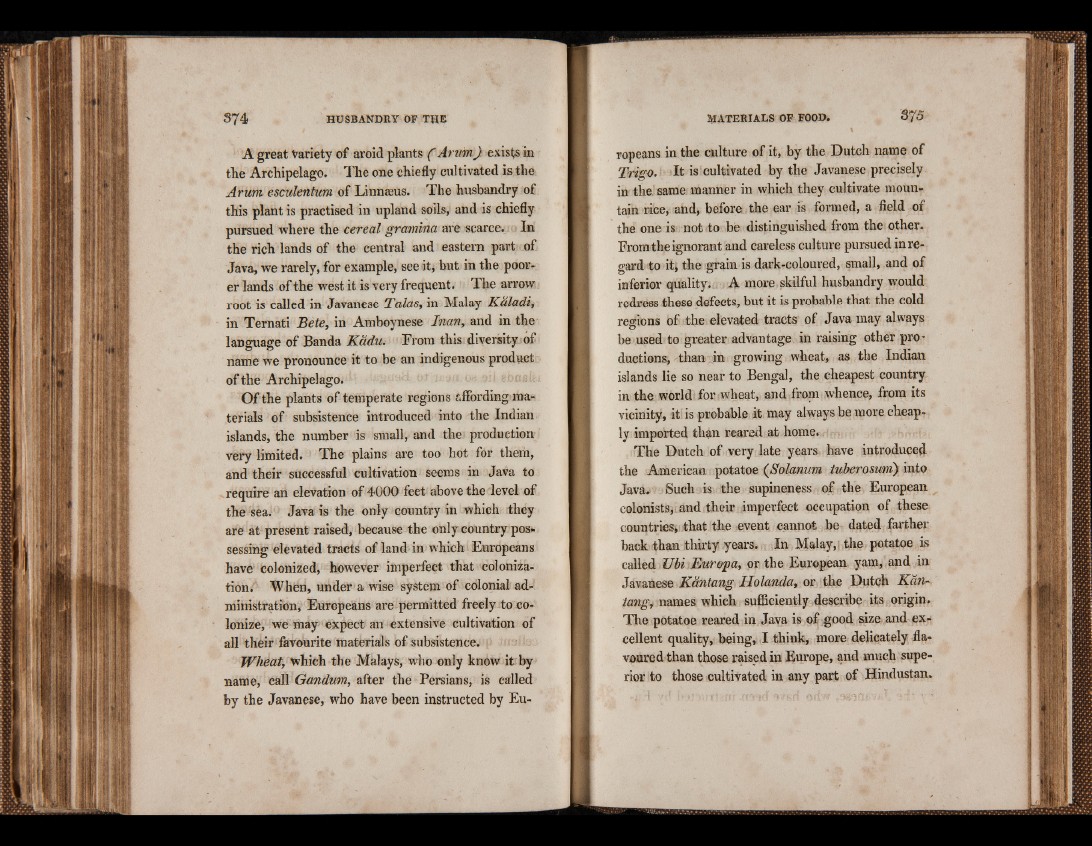
A great Variety of aroid plants (A rum ) exists in
the Archipelago. The one chiefly cultivated is the
Arum esculentum of Linnaeus. The husbandry of
this plant is practised in upland soils, and is chiefly
pursued where the cereal gramina are scarce. In
the rich lands of the central and eastern part of
Java, we rarely, for example, see it, but in the poorer
lands of the west it is very frequent. The arrow
root is called in Javanese Talas, in Malay Kaladi,
in Ternati Bete, in Amboynese Inan, and in the
language of Banda Kcidu. From this diversityjof
name we pronounce it to be an indigenous product
of the Archipelago.
Of the plants of temperate regions affording materials
of subsistence introduced into the Indian
islands, the number is small, and the production
very limited. The plains are too hot for them,
and their successful cultivation seems in Java to
require an elevation of 4000 feet above the level of
the sea. Java is the only country in which they
are at present raised, because the only country possessing
elevated tracts of land in which Europeans
have colonized, however imperfect that colonization.
When, under a wise system of colonial administration,
Europeans are permitted freely to colonize,
we may expect an extensive cultivation of
all their favourite materials of subsistence.
Wheat, which the Malays, who only know it by
name, call Gandum, after the Persians, is called
by the Javanese, who have been instructed by Europeans
in the culture of it, by the Dutch name of
Trigo. It is cultivated by the Javanese precisely
in the same manner in which they cultivate mountain
race, and, before the ear is formed, a field of
the one is not to be distinguished from the other.
From the ignorant and careless culture pursued in regard
to itj the grain is dark-coloured, small, and of
inferior quality. A more skilful husbandry would
redress these defects, but it is probable that the cold
regions of the elevated tracts of Java may always
be used to greater advantage in raising other pro'
ductions, than in growing wheat, as the Indian
islands lie so near to Bengal, the cheapest country
in the world for wheat, and from whence, from its
vicinity, it is probable it may always be more cheaply
imported than reared at home..*. >
The Dutch of very late years have introduced
the American potatoe (Solatium tuberosum) into
Java. Such is the supineness of the European
colonists, and their imperfect occupation of these
countries, that the event cannot be dated farther
back than thirty years. In Malay,I the potatoe is
called Ubi Europa, or the European yam, and in
Javanese Kantang llolanda, or the Dutch Kdtu
tang, names which sufficiently describe its origin.
The potatoe reared in Java is of good size and excellent
quality, being, I think, more delicately flavoured
than those raised in Europe, and much superior
to those cultivated in any part of Hindustan.